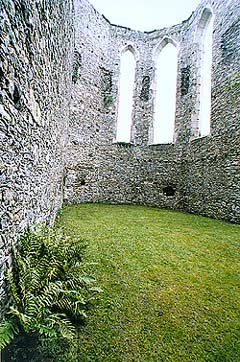Castle and Monastery of Kuklov
 Location:
Location:
The castle and monastery of Kuklov is located about 3 km to the
north of Brloh.
Origin of the Name:
The name Kuklov (the German name is Kugleweid) is probably derived
from the Latin word cuculla (hood, helmet) and from the German word
Weid (pasture). Literally we can talk about hooded pasture.

|

|
Description of the Place:
The ruins of the castle from the 14th century are located on a
rocky forest hill and consist of the remains of the walls and moat
that is quarried into rock. Near the castle ruins of a monastery of
the Paulians from the 15th century and the first half of the 16th
century are also situated. Also preserved there were the
circumference walls of a one nave Late Gothic church with
five-sided presbytery with two rests on the south side. The remains
of the church buildings are preserved only in the walls of the
houses that were founded later around the monastery ruins.
Architectural and Historical Development:
 The castle founded in the
14th century had a two-part character with the centre on a rocky
hill and with a wide barbican in the shape of a rectangle. In 1395
Kuklov castle was taken by force by the Rosenbergs and it was
destroyed. Since then the castle has been abandoned. Near the
castle ruins, the Paulians´ monastery was established in 1495. The
construction of the Late Gothic monastery was drawn out until the
middle of the 16th century and it has never been finished. In the
surrounding of the unfinished and unoccupied buildings new houses
were built step-by-step, the owners of which used the remains of
the monastery as a source of building material. Some of the houses
were directly built on the place of the former monastery. This fact
significantly influenced the character of the whole village.
The castle founded in the
14th century had a two-part character with the centre on a rocky
hill and with a wide barbican in the shape of a rectangle. In 1395
Kuklov castle was taken by force by the Rosenbergs and it was
destroyed. Since then the castle has been abandoned. Near the
castle ruins, the Paulians´ monastery was established in 1495. The
construction of the Late Gothic monastery was drawn out until the
middle of the 16th century and it has never been finished. In the
surrounding of the unfinished and unoccupied buildings new houses
were built step-by-step, the owners of which used the remains of
the monastery as a source of building material. Some of the houses
were directly built on the place of the former monastery. This fact
significantly influenced the character of the whole village.
Significant Architectural Features:
- saddle portal with rich profiled jamb in the north part of the
nave
- saddle portal in the remains of the monastery building dated 1514
History of the Monastery's Residents:
The founder of the Kuklov castle was probably bishop Jetřich
Mindenský who was famous for his work in Bohemia around 1357. When
he died, the castle was passed over to the king's property. Later
Kuklov castle became the reason for one of many disputes between
king Václav IV and the Praha archbishop Jan z Jenštejna. Their
conflict had an economical background that was provoked by the
Kuklov burgrave Václav ze Švamberka. At the time of the conspiracy
of the Czech aristocracy against Václav IV the royal castle of
Kuklov was taken by force by Henrich III. von Rosenberg in 1395 and
ruined. When the dispute was settled Václav IV gave the Kuklov
castle to the above mentioned Henrich III. von Rosenberg who did
not reconstruct it. Near Kuklov ruins a monastery of hermits of the
religious order of Saint Francis from Paula was established in
1495. The friars were called to Kuklov by Peter IV. von Rosenberg
and his brother Ulrich von Rosenberg. The Paulians began the
construction of their monastery and in the 16th century they also
added a brewery and a farm yard. Nevertheless the monastery has
never been finished and as time went by it was left and ruined.
During the Thirty Years´ War the castle probably abandoned was
ruined by the Swedish army.
Tales and legends:
When the Swedish soldiers came to the Kuklov castle they killed a
number of monks and the rest of friars who did not have enough time
to escape using an underground passage were captured and hanged up
on a big lime tree in front of the monastery. One of the rescued
monks, a devoted monk Erazim, settled in the deep forest called
Blanský les (Blanský forest) after this tragedy. He built himself a
hermitage on a glade and lived there only with the company of a
domesticated hind deer. Very soon he became in demand as a
spiritual adviser for many people from surrounding villages. But in
winter he was killed by wild animals. People buried the pieces of
his body beside his hermitage. Since then this place has been
called The Black Man's to remember the devoted hermit who was
called black because of the colour of his order's habits.
Present use:
Today in the neighbourhood of the monastery ruins there are houses.
The remains of the castle as well as the monastery are open to the
public.
Further information:
Ecclesiastical History in the Český Krumlov Region
(zp)



